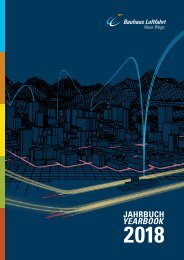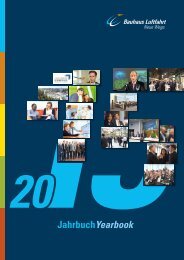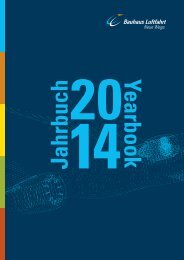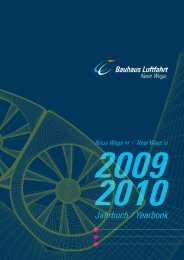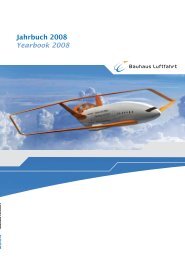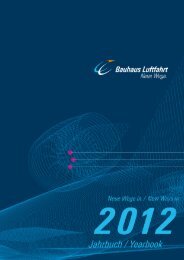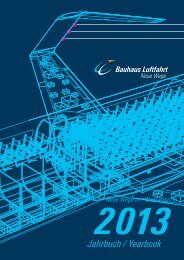Bauhaus Luftfahrt Jahrbuch 2019
- No tags were found...
You also want an ePaper? Increase the reach of your titles
YUMPU automatically turns print PDFs into web optimized ePapers that Google loves.
46 alternative fuels
Solar-thermochemische
Kraftstoffe: Status und
Perspektiven
Solar-thermochemical
Fuels: Status and
Perspectives
Die Umstellung von fossilem auf erneuerbaren
Kraftstoff ist eine der wichtigsten
Herausforderungen der Zukunft. Dies gilt insbesondere
für die Luftfahrt, die auf langen
Strecken auch weiterhin auf flüssige Kraftstoffe
angewiesen ist. Das Projekt SUN-to-
LIQUID (2016 –2019) nimmt diese Herausforderung
an, indem es die Produktion von
erneuerbarem Kerosin aus Wasser und CO 2
durch konzentriertes Sonnenlicht ermöglicht.
Dazu wurde die Kraftstoffproduktion unter
realen Bedingungen an einem Solarturm auf
dem Gelände des IMDEA-Energy-Institutes in
Spanien getestet, wo eigens für das Projekt
eine einzigartige Solaranlage mit integrierter
Fischer-Tropsch-Kraftstoffsynthese errichtet
wurde. Ein der Sonne folgendes Heliostatenfeld
konzentriert das Sonnenlicht um den
Faktor 2500, was der dreifachen Konzentration
im Vergleich zu Solaranlagen entspricht,
die derzeit zur Energiegewinnung eingesetzt
werden. Innerhalb des EU-geförderten Projektes
gelang damit nun erstmals die Herstellung
solaren Kerosins.
Das Bauhaus Luftfahrt untersuchte unter
anderem das geografische Produktionspotenzial,
indem es in einem ersten Schritt ungeeignete
Flächen (z. B. landwirtschaftliche Flächen,
Wälder, Schutzzonen oder Siedlungen) von der
Betrachtung ausschloss. Auf den verbleibenden
Flächen können dann die Produktionskosten
in Abhängigkeit von der Sonnenstrahlung
und den lokalen Finanzierungsbedingungen
berechnet werden. Die besten Standorte in
der Mittelmeerregion sind Israel, Spanien und
Marokko, mit Kosten von 1,4 EUR pro Liter.
Die Produktion kann beliebig skaliert werden,
was es erlauben würde, den Weltbedarf an
Kerosin zu Kosten von durchschnittlich 2 EUR
pro Liter zu decken. Das entwickelte Modell
kann für eine Kostenoptimierung auf lokaler
und nationaler Ebene verwendet werden.
SUNlight-to-LIQUID:
Integrierte solarthermochemische
Synthese flüssiger
Kraftstoffe
SUNlight-to-LIQUID:
Integrated solarthermochemical
synthesis of liquid
hydrocarbon fuels
This project has received
funding from the European
Union’s Horizon 2020
research and innovation
programme under grant
agreement No. 654408.
The transition from fossil fuels to renewable ones
is one of the largest challenges of the future. This
is true especially for aviation that will continue to
rely on liquid fuels for long-distance travel. The
project SUN-to-LIQUID (2016 –2019) rises to this
challenge establishing the production of renewable
jet fuel from water and CO 2 using concentrated
sunlight and Fischer-Tropsch synthesis. To this end,
the fuel synthesis was tested under real-world conditions
in an integrated plant erected specifically
for the project at IMDEA Energy Institute in Spain.
Solar energy is concentrated by a factor of 2500
by a heliostat field that follows the sun, which
corresponds to three times the concentration of
commercial concentrated plants for electricity
generation. In the EU-funded project, solar jet fuel
was produced for the first time last year.
Bauhaus Luftfahrt analysed, besides others,
the geographical production potential. In a first
step, unsuitable areas (e.g. agricultural areas,
forests, protected areas, or settlements) were
excluded. On the remaining areas, the production
costs can be estimated as a function of solar irradiation
and local financial conditions. The best locations
in the Mediterranean region are Israel, Spain,
and Morocco, with costs of 1.4 euros per litre. The
production can in principle be scaled up indefinitely,
what would allow to cover the world demand for
jet fuel at average costs of 2 euros per litre. The
developed model can be used for the optimisation
of costs on a local and national level.



